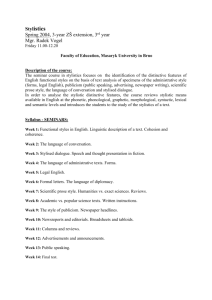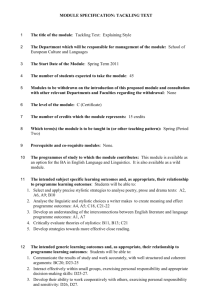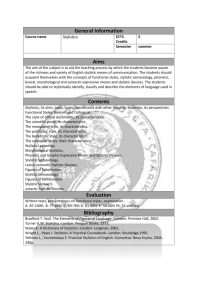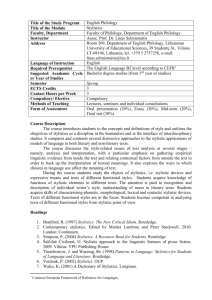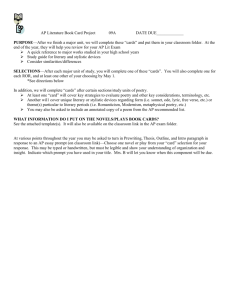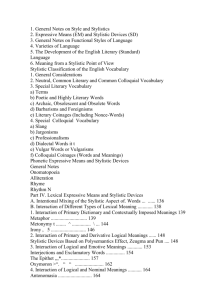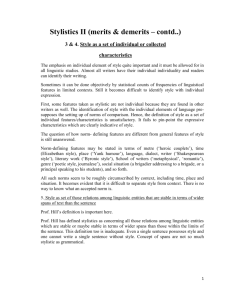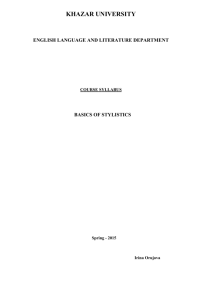Lecture and Seminar Aids - Кафедра лексикології і стилістики
advertisement
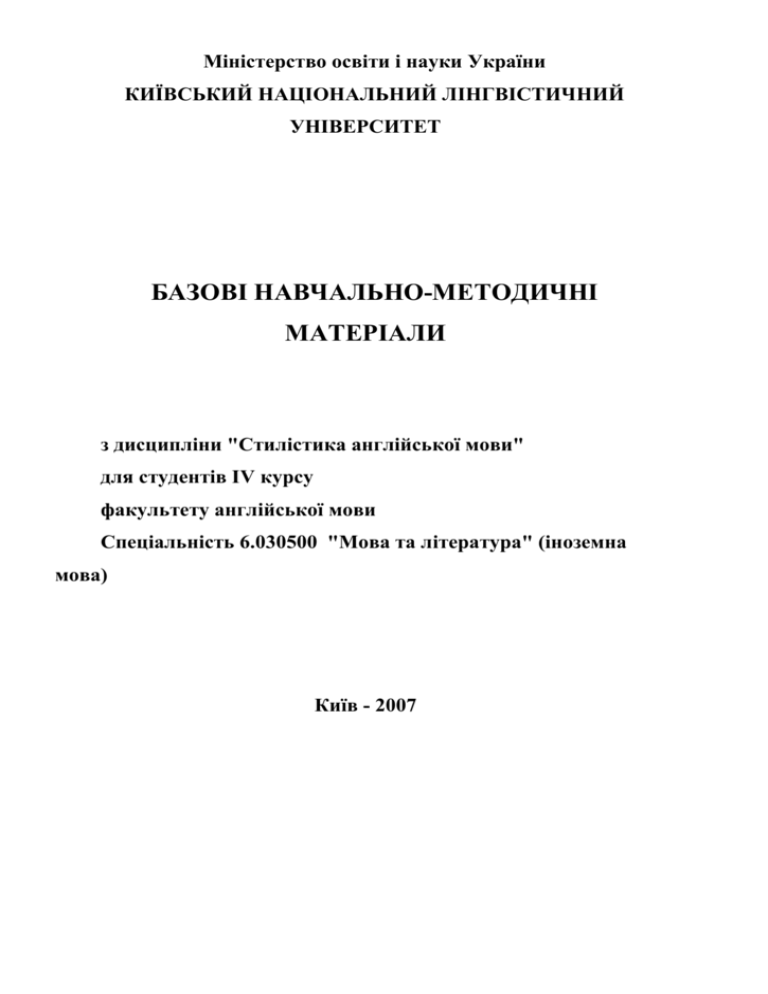
Міністерство освіти і науки України КИЇВСЬКИЙ НАЦІОНАЛЬНИЙ ЛІНГВІСТИЧНИЙ УНІВЕРСИТЕТ БАЗОВІ НАВЧАЛЬНО-МЕТОДИЧНІ МАТЕРІАЛИ з дисципліни "Стилістика англійської мови" для студентів ІV курсу факультету англійської мови Спеціальність 6.030500 "Мова та література" (іноземна мова) Київ - 2007 Ministry of Education and Science of Ukraine KYIV NATIONAL LIGUISTIC UNIVERSITY BASIC TEACHING MATERIALS in the Course of Stylistics of the English Language for Fourth-Year Students at the Department of the English Language Specialisation 6.030500 "Language and Literature" (English and Another Language) “ Kyiv – 2007 The Materials are based upon the Syllabus for the Course of English Stylistics taught to fourth-year students (Specialisation 6.030500 ‘Language and Literature’) at the Department of the English Language. Compiled by: I. E. Podolyan, Associate Professor of the Chair of English Lexicology and Stylistics Reviewed by: V.M. Tyahlovska, Associate Professor of the Chair of English Philology at the Department of Translation Head of the Chair of English Prof. Vorobyova O.P Lexicology and Stylistics: Coordinator: Prof. Shutov O.H. Assoc. Prof. Maksimenko A.M. Published on approval of the Academic Council of KNLU (Proceedings №_________ , ______________ 2007 ) 1. General Requirements to Students’ Knowledge, Abilities and Skills The main goal of teaching Modern English Stylistics as an academic subject is to introduce students to this discipline and its interrelations with other branches of linguistics. The updated syllabus of this course provides an insight into both structural and cognitive understanding of stylistic entities and phenomena, into multiaspect differentiation of speech registers, as well as into different contemporary approaches to text interpretation. The tasks of the course of lie in: –explaining students basic notions, concepts and problems of stylistics, –instructing them how to identify and analyse linguostylistic phenomena in the literary and other registers of language, –helping students to acquire philological competence in interpretation of the text as an artistic whole, –improving students’ general knowledge of English (at all of its structural levels) and developing their critical viewpoint upon stylistic peculiarities of language use. As a result of studying the course of English Stylistics students are expected to: –distinguish stylistic categories and phenomena from those of other linguistic disciplines, –comment upon functional roles of expressive means and stylistic devices in speech and discourse products, –know various approaches to stylistic differentiation of the English language, –choose units of different functional styles in accordance with appropriate linguistic contexts, –understand the literary text as a multi-layer construct and an open system that requires manifold approaches to its interpretation, –be philologically competent in applying linguostylistic and other types of analysis to the literary text, By the end of the course students should be able to present well-rounded interpretations of sample texts in the module test and at the examination. The significance of the course of Stylistics of English consists in improving fourthyear students’ linguistic and communicative competence that relates to their knowledge of structural language units and their functioning in speech. II. Subjects, Modules and Forms of Students’ Work The type of studies, The number of hours Including Total hourage Lectures Seminars Module №, Subject Self Study TERM 1. Module 1. Foundations of Stylistics, Stylistics of Structural Language Levels and Speech Registers Subject 1.1. Philosophical and General 6 2 2 2 Scientific Fundamentals of Stylistics Subject 1.2. General Linguistic 6 4 2 – Fundamentals and Basic Notions of Stylistics 6 2 – 4 Subject 1.3. Phonetic, Graphic and Morphological Means of Stylistics 10 4 2 4 Subject 1.4. Stylistic Lexicology of the English Language 6 2 2 2 Subject 1.5. Stylistic Syntax of the English Language 10 4 2 4 Subject 1.6. Stylistic Semasilogy of the English Language 8 2 2 4 Subject 1.7. Stylistic Differentiation of Modern English 2 Module test Total for Term 1. 2 54 20 14 20 TERM 2. Module 2. Basic Notions, Categories and Paradigms of Literary Text Interpretation Subject 2.1. Linguistic Aspects of Text 10 4 2 4 Interpretation. Basic Notions and Paradigms of Literary Text Interpretation. Subject 2.2. Image of the Author as a Literary Text Category Subject 2.3. Image of the Character as a Literary Text Category Subject 2.4. Image of the Reader as a Literary Text Category Module Test Module 3. Preparation for the examination Total for Term 2. Total for the academic year 7 2 1 4 7 2 1 4 10 4 2 4 --- 2 --- --- 36 12 32 8 22 52 72 2 72 126 III. Discipline Chapter The number and the names of module subjects, their contents (their aim, the main idea, the main problems, the key notions) the contents of practical classes Total hourage The name and contents of selfstudy work Hours Methods and for self- forms of current, study module and final work testing Module 1. Foundations of Stylistics, Stylistics of Structural Language Levels and Speech Registers Subject 1.1. Philosophical and General Scientific Fundamentals 6 2 2 of Stylistics Lecture 1 Stylistics as a Branch of Linguistics 2 Different oral The Aim of Studies: conceptions of questioning; To introduce students to Stylistics as a linguistic discipline stylistics as a written testing guided by the functional approach to the study of language, to linguistic explain the theoretical and practical significance of the course in discipline, of its the philological curriculum aims and contents The Main Idea: To indicate the place and role of Stylistics among other linguistic branches, to tell about its tasks and methods, and to show its interdisciplinary links The Main Problems: Elucidation of stylistic fundamentals and basic notions through the theory of information, discussion of properties of information The Key Notions: Functional approach, model of the information transmission, oral denotative and connotative information, redundancy and questioning; predictability, loss and accumulation 2 written testing; Seminar 1. Philosophical and General Scientific simulation Fundamentals of Stylistics discourse The aim and contents: to assist students in mastering fundamentals of Stylistics through discussion of the theoretical issues on the basis of literary text fragments and discourse situation Subject 1.2. General Linguistic Fundamentals and Basic Notions of Stylistics Lecture 2 Basic Notions of Stylistics The Aim of Studies: To define the object and subject-matter of Stylistics, its basic notions, types and kinds The Main Idea: To elucidate the key notions of Stylistics, in particular those of style, image, norm and context, from the perspective of this discipline The Main Problems: To present different interpretations of style and image and to discuss various classifications of Stylistics The Key Notions: Style, norm, context, image, foregrounding, literary stylistics, linguostylistics Lecture 3 General Linguistic Fundamentals of Stylistics The Aim of Studies: To revise the basic categories and phenomena underlying Stylistics as any other language discipline; to explain the notions of expressive means and stylistic devices The Main Idea: To indicate the common points of study between Stylistics and situations 6 2 2 oral questioning; written testing related branches of linguistics, and to give the idea about theoretical specificities of this discipline The Main Problems: To define the categories of expressive means and stylistic devices as paradigmatic and syntagmatic phenomena The Key Notions: Syntagmatics, paradigmatics, invariant, variant, expressive means, stylistic device, marked and unmarked members of the opposition. Seminar 2. General Linguistic Fundamentals and Basic Notions of Stylistics The aim and contents: to ensure students’ understanding of basic linguistic and specific stylistic notions through analysis of literary text fragments; to make a first introduction to linguostylistic analysis Subject 1.3. Phonetic, Graphic and Morphological Means of Stylistics Lecture 4 Expressive Means and Stylistic Devices at the Phonological and Morphological Levels The Aim of Studies: To define phonetic, graphic and morphological means and devices of stylistics, to outline their types and kinds, discourse and textual roles The Main Idea: To emphasise significance of these stylistic means for organization of utterances and texts, to show their differences from unmarked members of stylistic oppositions The Main Problems: 2 6 2 Sound symbolism. Patterns of rhythm and rhyme in poetry. English and Ukrainian morphological means and devices in comparison 4 oral questioning; written testing 4 Stylistic functions of phraseology in oral questioning; written testing; linguostylistic analysis of text fragments Various approaches to classification of grapho-phonemic and morphological means; means and devices specific to the English and Ukrainian languages The Key Notions: Versification, instrumentation, sound symbolism, violation of usual combinability, transposition of the meaning in context Subject 1.4. Stylistic Lexicology of the English Language Lecture 5 Stylistic Classification of the English Vocabulary. Words Having No Lexico-Stylistic Paradigm. The Aim of Studies: To expound the principles of stylistic classification of vocabulary and to pinpoint the major differences between neutral and stylistically coloured lexemes and phrasemes; to expand upon speech functions of words having no lexico-stylistic paradigm The Main Idea: To present the classification of vocabulary from the functional perspective, as opposed to the previously learnt substantial and structural approaches The Main Problems: Discourse and text roles of words and set phrases belonging to different types and kinds of vocabulary; synonymy as a tool of word selection The Key Notions: Lexico-stylistic paradigm, denotative, connotative, low-flown, high-flown Lecture 6 Stylistic Functions of Words Having a Lexico-Stylistic Paradigm. Stylistic Phraseology. 10 2 2 belles-lettre and other functional styles. Low-flown vocabulary in modern literary and media discourse oral questioning; written testing oral questioning; written testing The Aim of Studies: To expand upon speech functions of words having a lexicostylistic paradigm; to present different ways of their grouping; to consider stylistic functions of set phrases The Main Idea: To juxtapose stylistically charged vocabulary with words and phrases having no lexico-stylistic paradigm, to deliberate upon stylistic effects of both types The Main Problems: Selection of an appropriate vocabulary item in accordance with contextual demands and speakers’ pragmatic aims The Key Notions: Poetic diction, archaic words, bookish words, slangisms, dialectisms, expansion and reduction of phraseologisms Seminar 3. Stylistic Lexicology of the English Language The aim and contents: to train students in interpretation of the stylistic functions of vocabulary items in literary texts, as well as in products of other registers; to deliberate upon functional appropriateness of a certain lexeme or phraseme in individual speech Subject 1.5. Stylistic Syntax of the English Language Lecture 7 Expressive Means and Stylistic Devices of Syntax The Aim of Studies: To outline types and kinds of stylistic expressive means and stylistic devices, to explicate their functions in fiction and other registers of speech The Main Idea: To discuss the roles of these stylistic means in organization of 2 6 2 oral questioning; written testing; linguostylistic analysis of text fragments Syntactical and compositional patterns typical of different speech registers oral questioning; written testing 4 2 utterances and texts, to show their differences from unmarked members of stylistic oppositions The Main Problems: Selection of a syntactical construction or pattern in accordance with the pragmatic aim; syntactical means and devices specific to the English and Ukrainian languages The Key Notions: Reduction and redundancy of the syntactical pattern, transposition of the syntactical meaning in context, formal and syntactic interaction of constructions, ellipsis, anaphora, parcellation, aposiopesis, chiasmus. Seminar 4. Stylistic Syntax of the English Language The aim and contents: to train students in identification and interpretation of syntactical expressive means and stylistic devices in various texts, with an emphasis upon fictional ones Subject 1.6. Stylistic Semasiology of the English Language Lecture 8 Semasiological Expressive Means and Stylistic Devices. Figures of Substitution The Aim of Studies: To outline types and kinds of semasiological expressive means and stylistic devices, to explain discourse and text functions of figures of substitution The Main Idea: To account for the cognitive and linguistic nature of figures of substitution, to discuss reasons for their usage in speech The Main Problems: Metaphor and metonymy as basic cognitive entities; figures of substitution specific to the English and Ukrainian languages 10 2 Metaphorical and metonymical figures of speech from the perspective of Cognitive Linguistics oral questioning; written testing; linguostylistic analysis of text fragments oral questioning; written testing 2 oral questioning; written testing The Key Notions: Figures of quantity, figures of quality, cognitive metaphor, source domain, target domain, “stand-for” relationship, irony, hyperbole, epithet Lecture 9 Semasiological Expressive Means and Stylistic Devices. Figures of Combination The Aim of Studies: To explain discourse and text functions of figures of combination, to differentiate them from unmarked syntactical patterns The Main Idea: To dwell upon linguo-pragmatic and stylistic reasons for the use of semasiological stylistic devices in speech The Main Problems: Figures of combination as a means of stylistic and compositional arrangement of texts; figures of combination specific to the English and Ukrainian languages The Key Notions: Figures of identity, figures of inequality, figures of opposition, zeugma, pun, simile, antithesis, climax Seminar 5. Stylistic Semasiology of the English Language The aim and contents: to train students in identification and interpretation of semasiological expressive means and stylistic devices in various texts, with an emphasis upon fictional ones Subject 1.7. Stylistic Differentiation of Modern English Lecture 10 Functional Styles in Modern English The Aim of Studies: 4 2 8 2 Language and discourse features of official, scientific, publicistic, literary conversational, familiar colloquial and belles-lettre styles; types and genres of texts in each style oral questioning; written testing; linguostylistic analysis of text fragments oral questioning; written testing To present different classifications of functional styles (speech registers) in local and foreign linguistics; to discuss peculiarities of each register on every structural layer of language The Main Idea: To explain the communicative reasons for one’s choice of a language register; to outline content and formal differences between one-level language units that belong to different functional styles The Main Problems: Deductive and inductive approaches to classification of functional styles; stylistics of language, stylistics of speech activity and stylistics of speech products The Key Notions: Functional style, speech register, non-functional style, belleslettre style, scientific style, poetic language, practical language, oral code, written code Seminar 6. Functional Styles of Modern English The aim and contents: to ensure students’ understanding and knowledge of distinguishing characteristics of each functional style and its communicative factors of use. Module test Subject 2.1. Linguistic Aspects of Text Interpretation. Basic Notions and Paradigms of Literary Text Interpretation Lecture 11 Linguistic Aspects of Text Interpretation The Aim of Studies: To explicate the notion of a literary text as opposed to other types of texts; to explain the content and aims of text oral questioning; written testing; students’ research reports 2 10 2 Interpretation of a literary text in U.Eco’s, R.Bart’s, Yu.Lotman’s critical essays. Intertextuality as 4 oral questioning; written testing interpretation as a linguistic discipline The Main Idea: To outline different perspectives on text interpretation and to show its relations to other branches of linguistics The Main Problems: Text Interpretation as a methodology and a linguistic discipline; essential differences between text interpretation and linguostylistic analysis The Key Notions: Textual sense, textual meaning, objectivist paradigm of text interpretation, subjectivist paradigm, linguostylistics, text linguistics, literary stylistics Lecture 12 Basic Notions of Literary Text Interpretation The Aim of Studies: To outline and explicate main categories of a literary text; to dwell on integral units of the subtext The Main Idea: To present main categories of a literary text through its major structural and stylistic constituents; to provide guidelines for decoding of the subtext The Main Problems: A literary text as an integral unity having an implicit level; decoding artistic details and implicates as a key to understanding of the text message The Key Notions: Implicitness, discreteness, modality, conceptuality, artistic details, implicates Seminar 7. Literary Text Interpretation a stylistic and semiotic notion 2 oral questioning; written testing 2 7 2 4 Mikhail oral questioning; written testing; interpretation of literary text fragments The aim and contents: to train students in interpretation of a literary text as a whole, to help them with researching and decoding the subtext, to ensure their following the suggested pattern of text interpretation Subject 2.2. Image of the Author as a Literary Text Category Lecture 13 Image of the Author as an Anthropocentre of a Literary Text The Aim of Studies: To explain the notions of the author of a literary text and of the narrative perspective; to outline the types of literary narrators The Main Idea: To provide guidelines for decoding the narrator’s image and the narrative perspectives in a text of fiction The Main Problems: The literary author as a an external and internal category; different facets of focalization and degrees of perceptibility The Key Notions: Implied author, (un)limited narrator, facets of focalization, extradiegitic narrator, intradiegetic narrator, degrees of perceptibility Subject 2.3. Image of the Character as a Literary Text Category Lecture 13 Image of the Character as an Anthropocentre of a Literary Text The Aim of Studies: To present approaches to the status of fictional character and to view different classifications of fictional characters; to discuss basic methods of characterization The Main Idea: To provide guidelines for decoding the character’s image and Bakhtin’s theory of narrative. Roland Barthes works on the image of the author. The textual phenomenon of “stream of consciousness” 7 2 4 Contemporary classifications of fictional characters 2 oral questioning; written testing oral questioning; written testing for identifying methods of characterization in a text of fiction The Main Problems: The fictional character as a semiotic and literary category The Key Notions: Semiotic view of a character, flat character, round character, axis of complexity, axis of development, (in)direct characterization Seminar 8. Images of the Author and Character in a Literary Text The aim and contents: to train students in interpretation of images of the author and character in a literary text; to check up on their knowledge of different aspects of these images and their types and classifications Subject 2.4. Reader’s Image as a Literary Text Category Lecture 14 Image of the Reader as an Anthropocentre of a Literary Text The Aim of Studies: To introduce students to the notion of receptive semantics and to explicate the differences between the real reader and reader-inthe-text as a literary text construct The Main Idea: To present typology of in-text readers in literary discourse and to give guidelines for decoding the reader’s image The Main Problems: The reader’s image as a textual category; types of in-text readers The Key Notions: Receptive semantics, split addressee, recipient design, in-text reader, idealized addressee, hypothetical reader, empirical reader 10 2 4 Development of the notion “text addressee” in literary criticism and linguistics oral questioning; written testing; interpretation of literary text fragments oral questioning; written testing 2 oral questioning; written testing Lecture 15 Linguistic Signals of Addressee Orientation The Aim of Studies: To outline and specify all the types of linguistic signals of addressee-orientation (SAO) to instruct students in identifying and analyzing these signals The Main Idea: To instruct students in identifying and analyzing SAO in a literary text The Main Problems: The reader’s image as a linguistically represented category The Key Notions: Typology of SAO, functional specificity of SAO, distribution and range of SAO, means of foregrounding Seminar 9. Image of the Reader in a Literary Text The aim and contents: to train students in interpretation of the reader’s image following linguistic signals of addresseeorientation; to check up on their knowledge of the typology of text addressees Module test 2 2 oral questioning; written testing; interpretation of literary text fragments 2 IV. Samples of Assignments for Students’ Independent Work 1. Prepare a 10-15-minute class report on the phenomenon of sound symbolism as treated from different – psychological, physical, linguistic, aesthetic and other – perspectives. Use additional literature and on-line sources for the coverage of up-todate viewpoints on the phenomenon. Analyse the signs of sound symbolism and its effect on the reader on the basis of a poem. You can also investigate the effect of sound form on the recipient through advertising discourse. An interview or association test is recommended as a research tool for studying the addressees’ reactions. 2. Prepare a 10-15-minute class report on stylistic peculiarities of the publicistic style. Outline all genres and types of texts belonging to this speech register. Provide examples of such texts or their fragments on handouts for participants of the seminar. 3. Prepare a 10-15-minute class report on Mikhail Bakhtin’s theory of narrative. Study the recommended literature and comment on the two basic voice effects – “monologism” and “dialogism” – that can characterize a narrative text. Supply examples from literary discourse of various genres to illustrate the above effects. 4. Suggest your vision of the recipient design, characteristic of various discourse types, e.g. advertisements, scientific discourse, newspaper articles, etc. Comment on the points of similarity and difference between the discourse you choose and conventional (or literary discourse), viewed from the recipient design perspective. Self-Study Topics in Stylistics 1. Different conceptions of Stylistics as a linguistic discipline, of its aims and contents. 2. Sound symbolism. 3. Patterns of rhythm and rhyme in modern poetry. 4. A contrastive analysis of English and Ukrainian morphological means and devices. 5. Stylistic functions of phraseology in belles-lettre and other speech registers. 6. Low-flown vocabulary in modern literary and media discourse. 7. Syntactical and compositional patterns pertaining to different speech registers. 8. Metaphorical and metonymical figures of speech from the perspective of Cognitive Linguistics. 9. Typology of texts and their genres in different speech registers. 10. U.Eco’s, R.Bart’s and Yu.Lotman’s critical essays on literary text interpretation. 11. Intertextuality as a stylistic and semiotic notion. 12. Mikhail Bakhtin’s theory of narrative. 13. Image of the author as a notion discussed in Roland Barthes’ works. 14. “Stream of consciousness” as a textual phenomenon. 15. Contemporary classifications of fictional characters. 16. Evolution of the notion “text addressee” in literary criticism and linguostylistics. V. Sample of the Module Test Module Test № 1 on the Course of Stylistics of the English Language for Fourth-Year Students of the English Department Variant 1 General Notions (max. 15 %) 1. Complete the statement with the correct term. The whole set of linear relations between the language units of one level within the framework of the unit belonging to a higher level is called ____________. 2. Choose the correct completion of the statement. In studying language, stylistics chiefly leans upon a) the functional approach b) the structural approach c) the substantial approach 3. Choose the correct completion of the statement. Materialized information clothed in a sound form is called a) message b) signal c) code 4. Give a one-sentence definition to the notion of thesaurus. 5. Fill in the correct term. Divergence between the sender’s and addressee’s codes, polysemy, physical noise, changes in the transmission channel are classified as ______________ to communication. 6. “Style is the man himself” (G.Buffon) is a famous interdisciplinary definition of style. Provide another definition of style as a semiotic notion. 7. Complete the statement with the correct term. The most correct and prestigious style of speech established in the society within the given period of time is ______________. 8. Choose the correct completion of the statement. Rendering the message an additional or different sense as a result of its decoding is a) redundancy of information b) accumulation of information c) predictability of information 9. Name the three main types of context, completing the classification: a) linguistic b) c) 10. Choose the correct completion of the statement. By constellation one understands a) a combination of units belonging to the same register in one context b) a combination of units belonging to different registers in one context c) a type of paradigmatic relations behind a stylistic device 11. Which of the two definitions is true? a) The vehicle of a stylistic image is the naming notion. b) The vehicle of a stylistic image is the named notion. 12. Choose the correct completion of the statement. Genetic stylistics a) aims at revealing the author’s intention b) deals with the reader’s perception of the literary work c) disengages itself from the author’s intention and the reader’s perception Stylistic Phonetics and Morphology (max. 5 %) 13. Onomatopoeia can be defined as a) a combination of speech sounds which aims at imitating sounds produced by nature, people or animals b) an effect of ease and comfort in pronouncing and hearing c) a repetition of similar vowel sounds in close succession aimed at phonetic and semantic organization of an utterance 14. Find a mistake in the following statement and re-write it correcting one word only. The abundance of morphological expressive means in English is predetermined by its analytical character. 15. Determine to which parts of speech the following morphostylistic terms pertain. For each term choose between the three options in brackets: a) Pluralis Modestial (a pronoun? a verb? a noun?) b) “Editorial we” (a pronoun? an article? a noun?) 16. Identify the morphological device in the following sentence: “It was a dead leaf, deader than the deadest tree leaf.” Stylistic Lexicology (max. 10 %) 17. Which of the following is not true? a) Lexical meaning is basic while stylistic one is additional. b) Lexical meaning is more flexible and changeable whereas stylistic one is more stable. c) Lexical meaning is explicit while stylistic one is, for the most part, implicit. 18. Words having a lexico-stylistic paradigm are characterised by a) direct reference to the denotate b) indirect reference to the denotate c) no connotations 19. Select the two obligatory characteristics that pertain to expressive meaning: a) indirect reference to the denotate b) constant usage in a certain speech sphere c) metaphoric transfer 20. Which of the following do not belong to the class of words having a lexicostylistic paradigm a) archaic forms of words b) barbarisms c) foreign words 21. Organize the following groups of words into the two major classes, name these classes: slangisms, borrowings, dialectisms, bookish words, neologisms, archaisms, vulgarisms, exotisms. 22. Provide a one- or two-sentence explanation of the differences between lexical neologisms and stylistic neologisms. 23. Which of the following types of structural transformation of phraseologisms is not true? a) expansion b) reduction c) convergence Stylistic Syntax (max. 5 %) 24. Point out which of the syntactical stylistic devices given below can be defined as a deliberate break of a sentence into two separate sentences or clauses: a) aposiopesis b) parcellation c) ellipsis 25. Identify the type of repetition in the following: “Yes, but I was afraid, afraid I’d go to one who’d tell Paul.” a) ordinary b) catch d) chain 26. What syntactical EM is employed in the given sentence? “The widow Douglas, she took me for her son.” 27. Define the two syntactical expressive means that were used to create gradation in the given sentence: “He was her Europe, her emperor, her allied monarchs and august prince regent.” Stylistic Semasiology (max. 10 %) 28. Choose the correct completion of the statement. Metaphors which are used as a means of giving a name to an object produced by people in imaginary similarity of associations or emotions caused by the object, are called a) cognitive metaphors b) nominative metaphors c) generalizing metaphors 29. Which of the following statements is true? a) Irony is a figure of the metaphorical group. b) Irony is based upon the opposition of form and meaning. c) Irony is always expressed through graphical or paralinguistic markers. 30. Organize the following figures into the two groups: synecdoche, metaphor, allegory, periphrasis, epithet, euphemism. 31. Which of the statements contain oxymoron? a) He was condemned to a living death. b) “Make mine a whiskey sour, please!” c) No light, but rather darkness visible. 32. Which figure of substitution is defined as a deliberate understatement of some feature? 33. Which figure of combination creates a humorous effect in the following statement? “The man who is always asking for a loan is always left alone.” 34. By the stylistic criterion synonyms can be grouped into: synonyms-specifiers and ________________. 35. Define which of the figures – metaphor or metonymy – the following epithets are based upon: cat-and-dog life, a freezing mood, the kitten of a woman, a majestic sun. Stylistic Differentiation of English (max. 5 %) 36. Choose the correct completion of the statement. Practical oral, practical written, poetic oral and poetic written subsystems are a) functional styles b) functional types of language c) functional types of speech 37. Genres of the texts are distinguished according to their a) semantic feature and thematic characteristics c) compositional and stylistic properties d) all of the above 38. Fill in the gap with the correct term. While V.V. Vinogradov distinguishes the conversational style only, O.M. Morokhovsky differentiates between the literary conversational style and ________________________ style. 39. The genre of essay belongs to a) the scientific style b) the publicistic style c) the belles-lettre style 40. Fill in the gap with the correct term. O.M. Morokhovsky refers business, legal, diplomatic and military documents to the __________________________ style. Practical Assignment (max. 50 %: “5”– 50 %, “4” – 40 %, “3”– 30%, “2”– 20 % ) Offer a comprehensive linguostylistic analysis of the following excerpt. On the shore of the French Riviera, about half-way between Marseilles and the Italian border, stood a large, proud, rose-coloured hotel. Deferential palms cooled its flushed façade, and before it stretched a short dazzling beach. Now it has become a summer resort of notable and fashionable people; in 1925 it was almost deserted after its English clientele went north in April; only the cupolas of a dozen old villas rotted like water lilies among the massed pines between Gausse’s Hotel des Étrangers and Cannes, five miles away. The hotel and its bright tan prayer rug of a beach were one. In the early morning the distant image of Cannes, the pink and cream old fortifications, the purple Alp that bounded Italy, were cast across the water and lay quavering in the ripples and rings sent up by sea-plants through the clear shallows. (From F.S.Fitzgerald. Tender is the Night.) Test Evaluation (Explanatory Note) A student’s total score for the test is comprised of maximum 50% for the theoretical part and maximum 50% for the practical part. Each question of the theoretical part is estimated from 0 to 3%, depending on the number of problem points tested. The exact value of each question is indicated in the keys to the questions. Total Score: 20 points – 81-100 %, 16 points – 61-80% , 12 points – 41-60 %, 8 points – below 41 %. Evaluation Criteria for the Linguostylistic Analysis: A student deserves 50% of the test result if: 1. a linguostylistic analysis of the fragment is done in compliance with the academic requirements, both in content and form; 2. three (3) mistakes in spelling, grammar, lexical selection and stylistic usage have been made. A student deserves 40% of the test result if: 1. a linguostylistic analysis of the fragment is done in compliance with the academic requirements, with one (1) of them inaccurately or incompletely fulfilled; 2. two (2) mistakes in spelling or grammar and four (4) mistakes in lexical selection and stylistic usage have been made. A student deserves 30% of the test result if: 1. a linguostylistic analysis of the fragment is done in compliance with the academic requirements, with two (2) of them inaccurately or incompletely fulfilled; 2. three (3) mistakes in spelling or grammar and five (5) mistakes in lexical selection and stylistic usage have been made. A student deserves 20% of the test result if: 1. a linguostylistic analysis of the fragment is not done in compliance with the academic requirements; 2. four (4) mistakes in spelling or grammar and six (6) mistakes in lexical selection and stylistic usage have been made. A student deserves 0% of the test result if: no linguostylistic analysis of the fragment was completed. VI. Rating System and Assessment Criteria The assessment of a student’s academic progress is maintained within the national system of scoring (“5”, “4”, “3”, “2”). At the end of each module a tutor works out the average score adding up the scores for a student’s class work activity, self-study work and module test result. 1. Student’s Classwork: “5” – 10 points “4” – 8 points “3” – 6 points “2” – 4 points missed classwork – 0 points 2. Self – Study Work: “5” – 10 points “4” – 8 points “3” – 6 points “2” – 4 points not done – 0 points 3. Module Test: “5” – 20 points “4” – 16 points “3” – 12 points “2” – 8 points not done – 0 points Results of self-study work are presented at seminars in the form of oral answers and reports. The assignments for students’ independent work are suggested as either additional questions or further activities tasks in manuals in Stylistics and on lecture and seminar handouts. Each student is required to make two 10-minute oral reports on the suggested self-study topics during the seminars. An oral report based upon a student’s independent research is evaluated maximally at 5 points. The maximum score a student can gain for one module makes up 40 points. Module evaluation is done in the following way: Score Mark 36 points and more “excellent” 30 – 35 points “good” 20 – 29 points “satisfactory” 19 points and less “unsatisfactory” The maximum end-of-term score makes up 80 points. The term mark before the examination session is determined according to the traditional 4 – rate Ukrainian mark system Score Mark 72 points and more “excellent” 60 – 71 points “good” 40 – 59 points “satisfactory” 39 points and less “unsatisfactory” The students who have the term mark “excellent” or “good” before the session get their mark for the examination according to their term rating. All other students and those who want to upgrade their final score pass the examination. End-of-term End-of-term 4 – rate ECTS mark score final score Ukrainian mark 72 and more 172 and more A excellent 63 – 71 148 – 156 B good 60 - 62 145 - 147 C VII. Final Assessment Final assessment is exercised by means of oral examination. An examination card in Stylistics contains 3 problems: 1. a theoretical problem concerned with the study material of Module 1; 2. a theoretical problem concerned with the study material of Module 2; 3. a practical assignment pertaining to linguostylistic analysis and interpretation of a literary text. Evaluation Criteria: “Excellent” mark is given if: 1. a theoretical problem based upon Module 1 is entirely covered; a student demonstrates his/her knowledge of 90-100 % of the study material; 1-2 Stylisticsrelated mistakes are allowed; 2. a theoretical problem based upon Module 2 is entirely covered; a student demonstrates his/her knowledge of 90-100 % of the study material; 1-2 Stylisticsrelated mistakes are allowed; 3. a student’s linguostylistic analysis and interpretation of the sample text analysis is complete and correct; 1-2 Stylistics-related mistakes are allowed. “Good” mark is given if: 1. a theoretical problem based upon Module 1 is covered in 75 - 90 % of the required volume, 3-5 Stylistics-related mistakes are allowed; 2. a theoretical problem based upon Module 2 is covered in 75 - 90 % of the required volume, 3-5 Stylistics-related mistakes are allowed; 3. a student’s linguostylistic analysis and interpretation of the sample text analysis represents 75 - 90 % of the required volume; 3-5 Stylistics-related mistakes are allowed. . “Satisfactory” mark is given if: 1. a theoretical problem based upon Module 1 is covered in 50 - 75 % of the required volume, 5-8 Stylistics-related mistakes are allowed; 2. a theoretical problem based upon Module 2 is covered in 50 - 75 % of the required volume, 5-8 Stylistics-related mistakes are allowed; 3. a student’s linguostylistic analysis and interpretation of the sample text analysis represents 50 - 75 % of the required volume; 5-8 Stylistics-related mistakes are allowed. “Unsatisfactory” mark is given for: 1. a theoretical problem based upon Module 1 covers less than 50% of the volume, there are more than 8 Stylistics-related mistakes. 2. a theoretical problem based upon Module 2 covers less than 50% of the volume, there are more than 8 Stylistics-related mistakes. 3. a student’s linguostylistic analysis and interpretation of the sample text analysis represents less than 50% of the volume, there are more than 8 Stylistics-related mistakes. The Final Examination Mark is put in the following way: “excellent” – 5,5,5; 5,5,4; 4,5,5; 5,4,5 “good” – 5,4,4; 4,4,5; 5,5,3; 5,3,5 “satisfactory” – 3,3,3; 3,3,4; 5,3,3; 3,3,5 3,3,2; 3,2,3; 2,3,3 ; 3,3,2 “bad” – 2,2,2; 2,2,3; 2,3,4; 2,3,2; 3,2,2; 3,2,4 End –of–Term Rating and Evaluation: Marks obtained by students at the examination are translated into examination points in the following way: “excellent” – 100 points “good” – 85 points “satisfactory” – 70 points “unsatisfactory” – 50 points The final end-of-term rating is made of the sum of the scores for 2 modules plus the score gained at the examination. This sum is translated into the 4-rate national evaluation system and 7-rate European evaluation system according to the following scale: End-of-Term Final 4-rate Ukrainian ECTS Mark Score Mark 162 points and more A excellent 148-161 points 135-147 points 119-134 points 108-118 points 90-107 points 89 and less B C D E FX F good satisfactory unsatisfactory Sample of the Examination Card Kyiv National Linguistic University Chair of Lexicology and Stylistics of the English Language Specialization “Language and Literature” 6.030500 Subject: Stylistics of the English Language Term 8 Examination Card №2 1.The theory of image. The structure of image. 2. Publicistic style and oratorical style in Modern English. 3. Practical assignment: provide a complete linguostylistic analysis and interpretation of the fragment from F.S. Fitzgerald’s story “The Diamond as Big as a Ritz”. Approved at the sitting of the Chair of Lexicology and Stylistics of the English Language Record №________ from _____________ 2007 Head of the Chair _____________________________________O.P. Vorobyova Examiner_______________________ List of the Examination Questions Stylistics as a linguistic discipline. The subject-matter of Stylistics and its basic notions. General scientific background of linguostylistics. Information theory and stylistics. The definition of information. Different types of information. Information theory and linguistics. The major types of information from a linguostylistic perspective. 1. The principal model of information transfer. Its constituents. 2. The principal model of information transfer. Basic processes involved. Information loss and accumulation. 3. Types and kinds of stylistics. 4. Basic notions of stylistics: language, speech activity and speech; syntagmatics and paradigmatics; marked and unmarked members of stylistic opposition. 5. Basic notions of stylistics: style; individual style; norm; variant / invariant, context. 6. Basic notions of stylistics. Types of paradigms. Expressive means and stylistics devices. 7. Style and meaning. Meaning from the stylistic point of view. 8. Forms and varieties of language. The notion of received standard. 9. Basis for the stylistic differentiation of the English vocabulary; stylistic and functional style meaning of the word. Types of stylistic meanings of the word. 10. General characteristics of words which have lexical and stylistic paradigm. 11. Literary words and their stylistic functions: poetic diction, archaic word, barbarisms, bookish words. 12. The interrelations between archaic word, historic words, stylistic and lexical neologisms. 13. Conversational words and their classification. Their stylistic functions. 14. The notions of EM and SD on the syntactic level. 15. General characteristics of the English syntactical expressive means. 16. Syntactical EM based on the redundancy of elements of the neutral syntactic model. 17. Syntactical EM based on the violation of word order of elements of the neutral syntactic model. 18. Syntactic SD based on the interaction of several syntactic constructions within the utterance. 19. Syntactic SD based on the interaction of forms and types of syntactic connections between words, clauses, sentences. 20. Syntactic SD based on the interaction of the syntactic construction meaning with the context. 21. General characteristics of the English semasiological means of stylistics. 22. Classification of figures of substitution. EM based on the notion of quantity an EM based on the notion of quality. 23. General characteristics of figures of substitution as expressive means of semasiology. 24. General characteristics of figures of combination as stylistic devices of semasiology. 25. Figures of quality: general characteristics. 26. Figures of quantity: hyperbole, meiosis. 27. Figures of equivalence: simile, substituting and specifying synonyms. 28. Figures of non-equivalence: climax, anti-climax, pun, zeugma. 29. Metaphorical group. Mechanism of metaphoric transfer of name. Types of metaphor. 30. Metonymical group. Syntactic and semantic difference between metonymy and metaphor. 31. Figures of opposition: antithesis, oxymoron. 32. Irony. Context types of irony. 33. The problem of functional style in English. 34. Functional and non-functional variants of the English language. 35. The notion of functional style. 36. Deductive classification of functional style. 37. Inductive classification of functional style. 38. The style of official documents in Modern English. 39. The publicistic style and oratorical style in Modern English. 40. The style of scientific prose. 41. Text interpretation as a linguistic discipline: subject-matter, aims and tasks. 42. Hermeneutic, logical, psychological and philological perspectives of the literary text interpretation. 43. Basic notions of the literary text interpretation: textual reference and artistic model of the world. Fictitious time and space. 44. Basic notions of the literary text interpretation: text partitioning and composition. Implication and artistic detail. 45. The notion of the author in the narrative text. Internal and external aspects of the author’s textual presence. 46. The notion of the narrative perspective. Types of narrative perspective. 47. The narrator in the literary text. Types of narrators. 48. Approaches to fictional character in modern text interpretation. 49. Major classifications of the literary text characters. 50. Methods of characterisation of the literary text personage. 51. Perceptive semantics of the literary text. The notion of the “split addressee”. Major criteria for the differentiation of literary text addressees. 52. Reader-in-the-text as a literary text construct. Typology of “in-text” readers. 53. Linguistic signals of addressee-orientation. Cognitive mechanisms of their formation and functioning, their typology. VIII. Study and Training Sources and Aids Recommended Literature 1. Мороховський А.Н., Воробьева О.П., Лихошерст Н.И., Тимошенко З.В. Стилистика английського языка. – Киев, 1991. 2. Арнольд И.В. Стилистика современного английского языка. – Л., 1981. 3. Воробьева О.П. Текстовые категории и фактор адресата. – Киев, 1993. 4. Гальперин И.Р. Стилистика английского языка. – М., 1981. 5. Долинин К.А. Интерпретация текста. – М., 1985. 6. Домашнев А.Н., Шишкина И.П., Гончарова Е.А. Интерпретация художественного текста. – М., 1989. 7. Кухаренко В.А. Интерпретация текста. – Л., 1979. 8. Кухаренко В.А.Практикум по интерпретации текста.– М., 1987. 9. Єфімов Л.П. Стилістика англійської мови і дискурсивний аналіз. Учбовометодичний посібник. – Вінниця: «Нова книга», 2004. 10. Скребнев Ю.М. Основы стилистики английского язика: Учебник для интов и фак. иностр. яз. – 2-е изд. – М, 2003. 11. Kukharenko V.A. A Book of Practice in Stylistics. – Вінниця: «Нова книга», 2003. 12. Soshalskaya E.G., Prokhorova V.I. Stylistic Analysis. – M., 1976. 13. Vorobyova O.P. Literary Text: A Comparative Study // The Parasession on Theory and Data in Linguistics. - Chicago: Chicago Linguistic Society, 1996. P.165-175. 14. Методичні вказівки до семінарських та практичних занять із стилістики англійської мови для студентів IV курсу / Уклад. О.П.Воробйова, Л.Ф.Бойцан, Л.В.Ганецька, О.Ю.Дубенко, І.О.Іноземцева, Л.Р.Чеботарьова, Л.Д.Якимчук. – К.:КДЛУ, 1996 (1997). Additional literature: 1. Брандес М.П. Стилистика немецкого языка. М., 1983. 2. Гореликова М.И., Магомедова Д.М. Лингвистический анализ художественного текста. М., 1983. 3. Долинин К.А. Стилистика французского языка. Л., 1978. 4. Иванова Т.П., Брандес О.П. Стилистическая интерпретация текста. М., 1991. 5. Моисеева Л.Ф. Лингвистический анализ художественного текста. К., 1984. 6. Одинцов В.В. Стилистика текста. М., 1980. 7. Пелевина Н.Ф. Стилистический анализ художественного текста. Л., 1980. 8. Степанов Ю.С. Французская стилистика. М., 1965. 9. Borisova L.V. Interpreting Fiction. M., 1987. 10. Diakonova N., Arnold I. Three Centuries of English Poetry. L., 1967. 11. Diakonova N., Arnold I. Three Centuries of English Prose. L., 1967. 12. Sosnovskaya V.B. Analytical Reading. M., 1974. Lecture and Seminar Aids 1. Texts of all lectures on Stylistics presented in the computer programme Microsoft Power Point. 2. Supplementary transparencies on lecture and seminar points. 3. Lecture and seminar illustrating materials on handouts. 4. Supplementary lecture tests presented in the computer programme Microsoft Power Point.
